See Part II of this series on trees and religions here.
Re-visiting, once again, the European world, one can look back to the pre-Christian religions (including Hellenism and Paganism, the latter of which took many forms) that were common across the continent in the millennia gone by. As already established, the advent of Christianity in the first few centuries Anno Domini led to many sacred trees and groves losing their sanctity – or even losing their landscape presence – though prior to this, as is certainly incredibly clear from numerous historical sources, trees (and particularly certain species) were of marked importance for various European cultures (Cusack, 2011).
Celtic Paganism
Beginning with Celtic Paganism, which, like all forms of Paganism, is polytheistic in nature, there is an unmistakeable reverence of the natural world, and notably trees (Forest, 2014; Haberman, 2013), which were viewed as akin to persons (Hall, 2011), and could be infused with the divinity of deities (usually female, but not always) both major and minor (Cusack, 2011). As a precursor, unfortunately, because Celtic druids (one of the three ‘elite’ classes, who controlled religious and socio-political discourse and practice) did not write much down in the way of their religion and its associated customs, preferring to instead pass-on such knowledge via the spoken word, their worship of trees is told largely by the written accounts of the Romans and Christian priests and missionaries of the time (Cusack, 2011; Macculloch, 1911). Despite this, one can certainly begin to appreciate the value trees held for the Celts, and this begins with the axis mundi, of which the Celts considered a tree (likely the oak) to represent (Cusack, 2011; Forest, 2014).
It was, therefore, probably the oak tree that was the most revered of all tree species – particularly when it was being parasitised by the sacred mistletoe (Viscum album), as in such instances it would be seen as one of their deities’ chosen trees (Altman, 2000). The oak would thus be found abundantly within sacred groves frequented by the druids (used to worship deities such as Baal, who was the god of fire), where ceremonies religious in nature (including – at times very gruesome – human sacrifice), communal gatherings (for the purpose of learning and socialising), and legal discussions would be held (Altman, 2000; Cusack, 2011; de Cleene & Lejeune, 1999; Hooke, 2010; Macculloch, 1911). In fact, this is a common theme amongst all forms of Paganism, as trees usually display their sacredness through ritualistic practice. Other tree species, such as yew (Taxus baccata) were also to be found within the groves, and in many instances these groves of species including oak and yew would also be located near to a river or other water source (Cusack, 2011). Worship, in particular, would not be held indoors, but instead amongst these sacred groves (Monaghan, 2014), where no temple walls would have been built around such sacred locations that were often deep within the woodlands and away from settlements (Hageneder, 2000).
Curiously, the word druid may even translate to ‘oak men‘, as may the druids’ word for sanctuary originate from the Latin word nemus, which translates to mean ‘grove‘ (Haberman, 2013). In turn, this explains the name of the goddess of the sacred groves of the Celts: Nemetona (“goddess of the sacred grove”) (Forest, 2014). In Sanskrit, druid literally translates to ‘tree knowledge‘, where ‘dru‘ means tree and ‘wid‘ means knowledge (Hageneder, 2000). Of course, within these Celtic groves, other deities were worshipped, including Taranis (Cusack, 2011), who – much like other European thunder and storm gods (including Jupiter, Perkūnas, Perun, Thor, and Zeus – some are discussed later) – was represented by the oak tree (Forest, 2014; Gardiner, 2007). Perhaps this associations comes from the fact that lightning strikes can destroy even the strong oak (Davidson, 1988), and that oaks are perhaps more prone to lightning strikes than other European tree species (Cusack, 2011). More primordially, Altman (2000) details that the Celts considered themselves as descendants from trees, with man being of the alder (Alnus glutinosa) and women of the rowan (Sorbus aucuparia). The recognisable fertility of trees to the Celts, by virtue of their abundant fruit crops every year, also led to the onset of spring being celebrated in sacred groves. Such celebrations oft consisted of man and woman having sexual intercourse within a sacred grove, as they saw their fertility as being linked to the fertility of trees.

In Ireland, unlike the Celtic Pagan practices of elsewhere, there do exist more written records, because the Irish Pagans had their own form of alphabet that they inscribed onto stone and wood (particularly that of the yew – Taxus baccata): ogham (Cusack, 2011; Forest, 2014; Hagender, 2000; Macculloch, 1911). In total, the alphabet had 20 characters, of which many have direct associations with a species of tree – including alder, apple, ash, birch, hawthorn, hazel, oak, willow, and yew (de Cleene & Lejeune, 1999; Forest, 2014; Hageneder, 2000). Granted, there are a few instances where the language is used in England, Scotland, and Wales, though it is generally confined to the Irish areas of Cork, Kerry, and Waterford (Cusack, 2011; MacNeill, 1908).
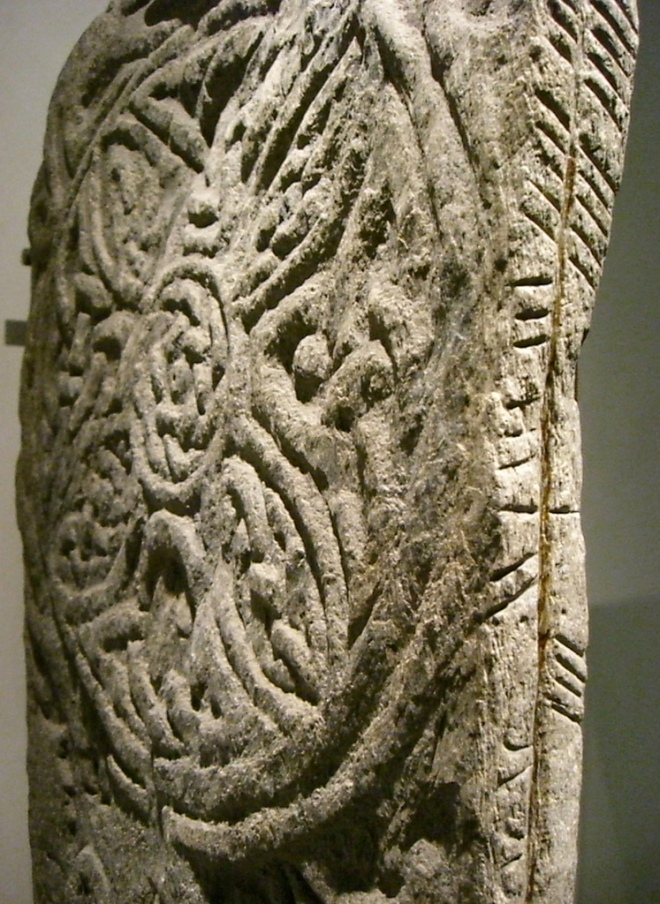
Because of this, though also courtesy of sources written by Christians, there is a slightly more detailed understanding of Paganism in Ireland, up to the 8th century Anno Domini. Principally, there were five major sacred trees (known as bile, or the plural biledha) within Ireland, in the Pagan era: Bile Dathi (an ash tree), Bile Tortan (an ash tree), Craeb Uisnig (an ash tree), Eó Mugna (the Oak of Moone), and Eó Rossa (the Yew of Ross) (Cusack, 2011; de Cleene & Lejeune, 1999). These sacred trees were considered as the axis mundi of particular domains, which were ruled over by a king, after the king had been inaugurated beneath the sacred tree (Davidson, 1988; Mac Cana, 2011), and also offered protection and shelter to all those who lived within the respective domains (Hooke, 2010). Beyond the inauguration of a king, a king may also be married to the sovereignty goddess beneath a given sacred tree. In such instances, the goddess represented both the land under the king’s rule, and the quality of leadership the king would display during his rule of such land (Cusack, 2011). More broadly, sacred trees would likely have been situated next to holy wells (Altman, 2000). Certain Irish tribes also named themselves after trees, such as how the Iverni tribe were named after the yew tree (Hageneder, 2000), which represented death and immortality (Hooke, 2010).
Anglo-Saxon Paganism
Alongside Irish Paganism, Anglo-Saxon Paganism developed, and was most prevalent in the late 5th to mid-late 7th centuries Anno Domini, following the decline of Celtic Paganism at the hands of the Roman Empire in Britain, and prior to the mass Christianising of the Anglo-Saxons by 670 A.D. (Cambria, 2015; Cusack, 2011). Again, and certainly unfortunately, much like Celtic Paganism, a great majority of sources available on the stance Anglo-Saxon Pagans held with regards to trees is obtained from Christian literature or pro-Pagan authors. For this reason, and the fact that this form of Paganism did not last for a great length of time, there is sparse literature available on how trees featured within religious practice (Cusack, 2011), and instead attention is drawn to Germanic Paganism, which was the forebear of the Anglo-Saxon strain of Paganism.
However, Anglo-Saxon texts do reveal certain aspects of the Pagan religion and trees, with the Anglo-Saxon god Wōden (Óðinn, in the Norse religion that came later), who hung on the Cosmic Tree in order to try to find the answer to the riddle of death and, in doing so, identified the power of the Runes (for Anglo-Saxons, there were two runic alphabets comprising of 28 letters, of which four had tree names: ash, birch, oak, and yew), being one example (Cusack, 2011; Viladesau, 2006).
On the topic of individuals hanging upon trees, the Anglian myth of the sacrificial king known as Ingui, who married, in spring, a woman who was the manifestation of the goddess of the land, and was killed the following spring by another man and hung upon a tree, is a further reference to trees within Anglo-Saxon Paganism – in particular, the cosmic tree (Cusack, 2011). With regards to the worship of gods and goddesses within sacred groves by the Anglo-Saxons, it is understood that a grove would be a sacred site of solely one deity; as in the case of Thundersley in Essex being the place of worship for the god Thunor (Þórr), the god of the skies and son of Wōden (Cambria, 2015). Beyond the symbolism, the yew (Taxus baccata) and linden (Tilia cordata and Tilia platyphyllos) were important trees within the religion, and tribes met under these trees for festivals and for council (Hageneder, 2000).

Germanic Paganism
As established above, Anglo-Saxon Paganism had its roots firmly in Germanic Paganism, the religion which the Germanic cultures that migrated to England would have largely practiced up until the end of the 7th century, when Christianity became the predominant religion. Akin to other forms of Paganism, very little was ever documented in written form by those of the faith, and instead texts detailing the religion’s relationship with trees are provided by other cultures – in this case, the Romans, and notably the senator Tacitus (Chadwick, 1900; Cusack, 2011). Two notable sacred trees for the Germanic peoples (both detailed more explicitly later) were the Donar Oak, which was used to worship Thunor, and a tree trunk (pillar monument) known as Irminsul, though by-and-large it was considered, by Tacitus, that tree groves in general were the home of the gods.
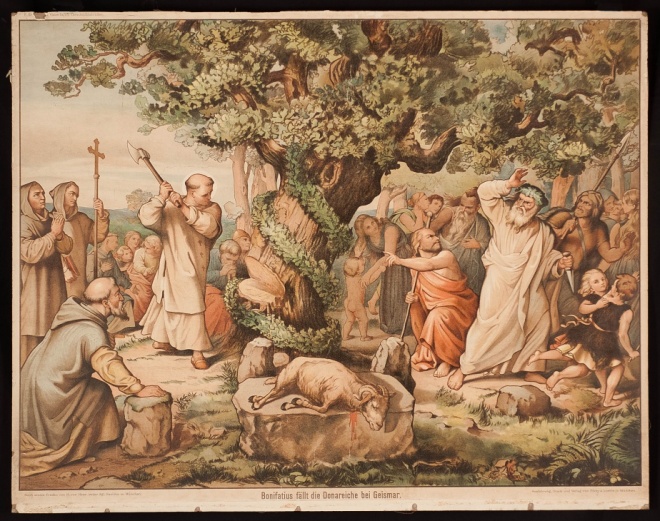
The sacred grove of the Semnones, a Germanic tribe who belonged to the Suebi culture, is regarded by Tacitus as the most prominent of all sacred groves, and in the bounds of this grove the tribe worships their sky god who “rules over all” (suspected to be Tiwaz, otherwise known as Týr), through rituals including bloody human sacrifice (Chadwick, 1900; Cusack, 2011; Davidson, 1988; Tolley, 2013). Wood of the alder (Alnus sp.) would have perhaps been used with these sacrifices (de Cleene & Lejeune, 1999).
Those who entered the sacred grove would also, at all times, have to be bound by a chain, highlighting their inferiority over the highest god, and if individuals were to fall they were required to roll out of the grove on the floor, in place of getting up and walking out (Dunn, 2013). Tolley (2013) also suggests, as does Gummere (1892) more broadly, that the tribe viewed the sacrifice of humans within the grove as representative of man’s origins from the world tree, and therefore also recognised that trees also symbolised death.
Beyond the Semnones tribe, the Nahanarvali tribe worshipped a pair of male deities, the Alci, within a sacred grove, where worship was overseen by a transvestite priest (Dowden, 2000). There is however some disagreement about whether the Alci were gods, or instead two tree pillars, as certain researchers suggest that the word translates to wooden icon (Cusack, 2011). Regardless, trees were either the vehicle of worship, or provided the grounds in which worship would take place – or both. Other Germanic tribes paid respect to the mother goddess, Nerthus, in further sacred groves (Dowden, 2000). Again, there are human sacrifices, though far less bloody – slaves assisting in the procession to the sacred grove of Nerthus, and taking part in the subsequent rituals, are simply drowned in the lake found within (Simek, 2014). Generally, the deities worshipped by Germanic tribes within sacred groves were female, and those individuals sacrificed would either be hung in their entirety, or in part, upon a sacred tree within the grove, following death (Gummere, 1892).
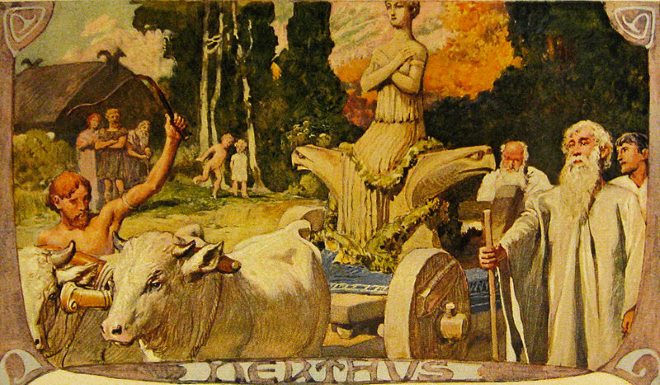
The Donar Oak, mentioned above, which was located at Geismar (in the region of Hesse) and was used by the locals to worship the thunder god Donar (otherwise known as Thunor, and in Nordic Paganism, Þórr), before meeting its untimely end at the hands of the Christian missionary Saint Boniface, was a very important sacred tree for the Chatti tribe, who preceded the later Hessian tribe (Cusack, 2011; Rhody, 2012). At the site of the oak, human (and animal) sacrifices would be undertaken, as well as other customary rituals, and this ‘barbaric’ series of practices was one driver behind its destruction during the Christianisation of the region (Schrader, 1983). Following its felling by Saint Boniface, a church was built at the location with the wood from the Donar Oak, and the Chatti tribe were said to have immediately converted to Christianity after Donar did not strike down and kill Saint Boniface during the felling process (Cusack, 2011; Rhody, 2014). However, other nearby tribes did not convert, and Saint Boniface was met with ferocity and thus the remainder of his mission was not overly fruitful.
Curiously, in the twelve months following the felling of the oak, a sapling fir tree was noticed as growing in close proximity to where the oak stood, and Saint Boniface took this as an act of God and thus a symbol of the Christian faith (notably the Holy Trinity). From this, German Christians began to keep firs within their properties, at times upside-down, and this may indeed be one of the origins of the Christmas Tree concept (Layser, 2000). As has already been mentioned, though it is nonetheless worth noting once more, great oaks throughout the forests of Germanic Pagan territory were associated with Thunor, which is much akin to how other Pagan cultures (as detailed prior, and also after this point) viewed the oak as being a representation of their respective thunder gods (Cusack, 2011).
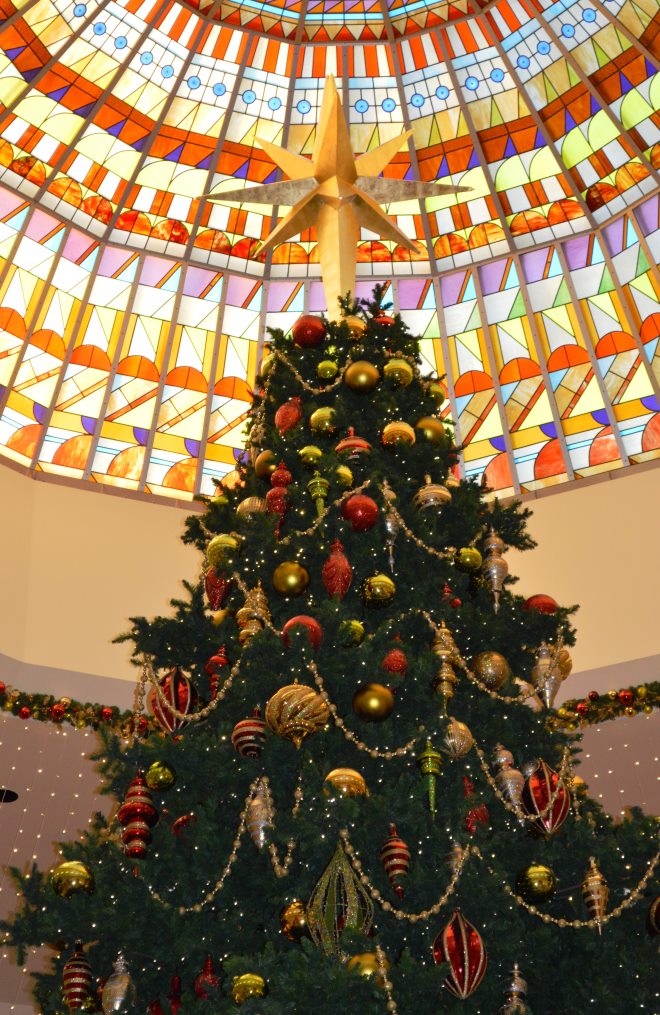
The second important tree for the Germanic Pagans was the pillar of Irminsul (synonymous with the Nordic Yggdrasil) in the Teutoburg Forest near the River Lippe at Eresburg (now Obermarsberg, Westphalia), which is likened to the axis mundi, or world axis; at this location, Cusack (2011) alleges that there was a “ritual complex”, thereby identifying the site as religiously (and also legally) crucial. This monument, evidently highly sacred to the Pagans in the sense that the pillar represented the worlds spanning from the depths to the heavens (and may have represented the sky god Tiwaz), was felled by Charlemagne (who was, at the time, the king of the Franks) in 772 A.D., as was the temple or sanctuary in which it was situated destroyed at the same time, over the course of three days (Bachrach, 2013; Cusack, 2011; Francis, 2014; Hooke, 2010). The offerings of gold and silver at the sacred site by Pagan visitors, left as a payment for protection by the gods, were also removed by Charlemagne’s troops (Wilson, 2005).
The intent behind this act was to aggressively denounce Paganism and establish a Christian rule over the local people, and following the felling of Irminsul Charlemagne also went on to forbid the worship in and of trees and forests. Failure to comply would result in a financial penalty (Butt, 2002; Cusack, 2011). Unfortunately for Charlemagne, the Germanic peoples did not take kindly to this usurpatious tendency, and for many decades following churches were burned and there were constant skirmishes. Even the church erected by Boniface at the site of the Donar Oak was nearly burned by the Hessians, in 773 A.D. (Cusack, 2011). Eventually, this tension led to greater issues, and wider-scale warfare broke out, until 810 A.D., when tensions calmed after the Pagans had been progressively, and in large numbers, brutally murdered, converted to Christianity, or sent into exile.
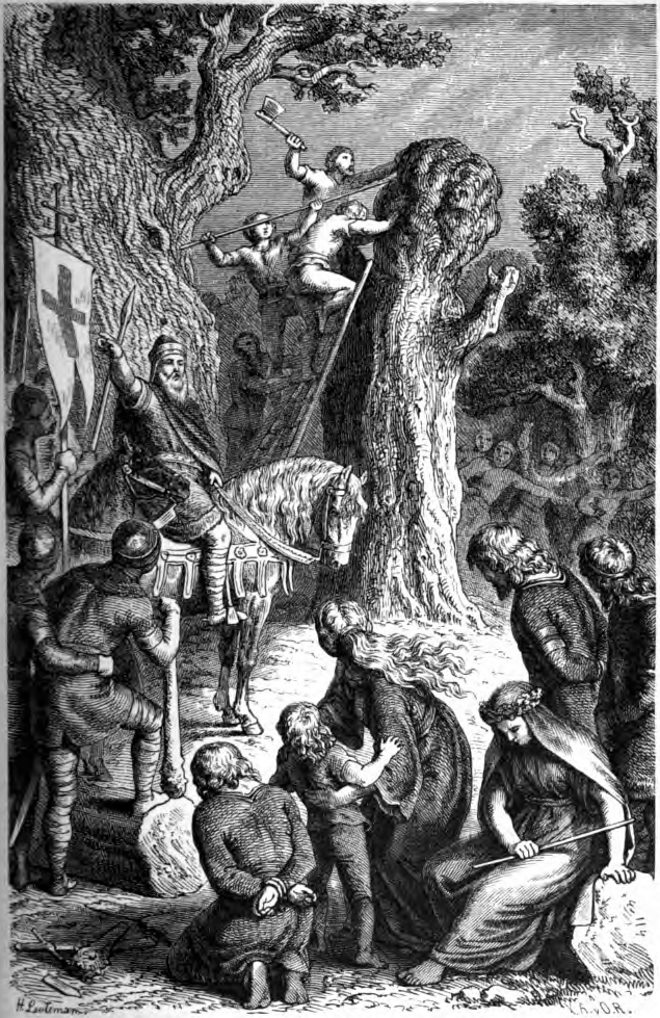
Nordic Paganism
A later manifestation of a form of Germanic Paganism, that of the Nordic religion, unquestionably also heavily revolves around the tree. Without any question, the most prominent symbolic feature of the Nordic religion is the tree of judgement and fate: Yggdrasil (Cusack, 2011; Murphy, 2013). This ash tree, or for some even a yew tree, serves as both the axis mundi, through which it supports the depths (Hel / Niflheim), the worldly realm (Midgard), and the heavens (Asgard), and the imago mundi, because it supports the nine worlds (Altman, 2000; Hageneder, 2000; Skoglund, 2012). As a cosmic tree, it came into being, symbolically, after Óðinn and his two brothers killed the giant Ymir and took him to the centre of Ginnungagap. From this location, the worlds manifested, and the roots of the ash begun to drink from the primeval waters of destiny (including from the well of fate or wyrd: Urðr).
Acting as the sacred tree of the Norsemen, Yggdrasil held the important position of being the symbol that connected humans with their gods (Cusack, 2011). It is also upon Yggdrasil that Óðinn hangs himself for nine days and nine nights (it is suggested that this may represent one day for each of the nine worlds that Yggdrasil unites), seeking the power of the runes (to see into the future and to understand the universe), which are thought to have been provided to him by the Norns (the three sisters, or weavers of destiny – of past, present, and future – situated under the ash: Skuld, Verðandi, and Urðr) (Altman, 2000; Hayman, 2003; Murphy, 2013; Skoglund, 2012; Tauring, 2007). These runes were eventually passed down to the humans via Þórr (Cusack, 2011). This hanging of himself upon the tree has distinct parallels with ancient Indo-European beliefs, and draws Yggdrasil into the idea of a tree representing a human; a human that, in turn, represents the world: the imago mundi (Cusack, 2011; Haberman, 2013).
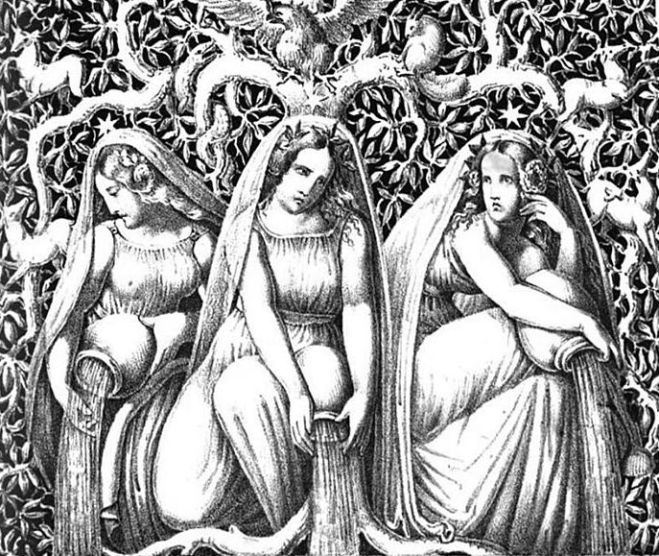
However, it is not Óðinn but his more extensively-revered son Þórr, as Cusack (2011) explains, who is the thunder (sky) god, and who therefore holds the most ‘important’ association with Yggdrasil as the axis mundi; this common association between sky gods and the world tree has been ever-present throughout Indo-European literature. Þórr’s role is – in relation to the axis mundi – the maintenance of the cosmos, through upholding its laws. He was even considered to have held court at the site of Yggdrasil (Andrén, 2014).
Unsurprisingly, such an association led to Norsemen worshipping Þórr within sacred groves, which would have comprised of oaks most notably, because of the genus’ association with the thunder god (Cerveny, 1994; Chadwick, 1900; Gardiner, 2007). One such grove in Uppsala, Sweden, at nine year intervals (relevant to the nine Worlds), would host all of the provinces of Sweden, kings and all. In this grove, as was customary of other Pagan cultures across Europe, rituals involving human and animal sacrifice would occur (nine male specimens of each living create would be sacrificed), and often would the corpses hang from the trees after their bloody death (Cusack, 2011; Orton, 2005). The trees upon which such bodies were hung, and upon whose bark the blood was spilled, were markedly sacred, because of their link to bodily putrefaction. It is thought that this male sacrifice is associated with the death of Ymir and the birth of the world (and not Yggdrasil), thereby meaning the rituals within the grove were a re-enactment of death and renewal (Cusack, 2011). Occasions where groves may have contained physical embodiments of Yggdrasil were when huge evergreen trees were found close by to wells, which mirrors the all-encompassing nature of Yggdrasil and the wells its roots drink from.
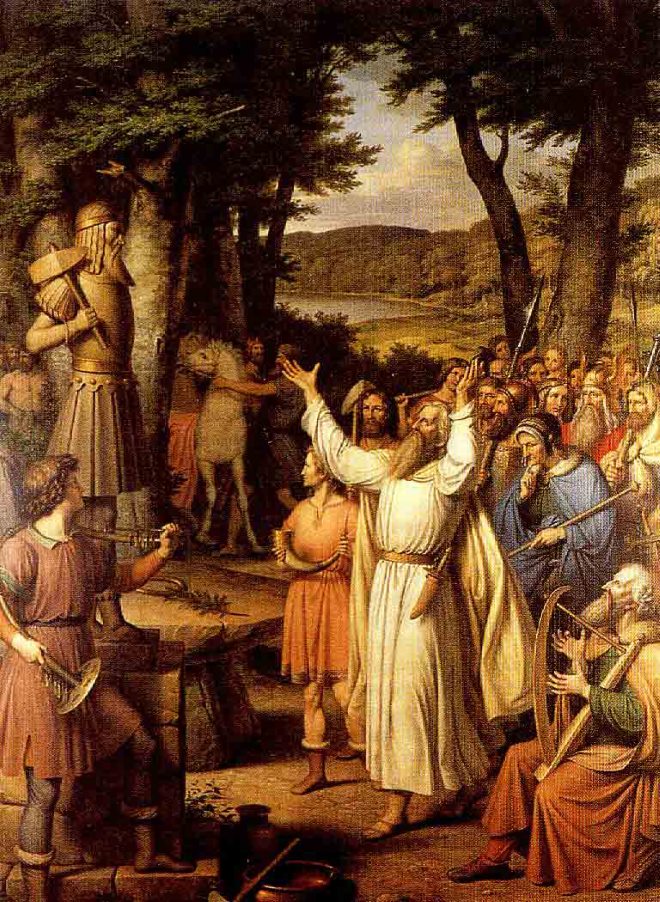
The Norse god Heimdallr, however, is also linked to Yggdrasil, and perhaps more so than Þórr – principally because Heimdallr may perhaps translate directly to mean ‘World Tree‘ (Andrén, 2014). Heimdallr, as the watchmen of the Nordic gods in Asgard and the son of nine Mothers, is likened to a guardian tree, and in fact is representative of the axis mundi, by linking Niflheim, Midgard, and Asgard. The trunk of Heimdallr, or the World Tree, is too symbolic from the perspective of the creation myth, by where Óðinn (and his brothers) created humans from two logs that washed ashore from the sea – one of both an ash and an elm (Cusack, 2011; Hall, 2011). In this sense, one can observe yet further associations between man and the tree, as it is considered that man originated from the tree.
Indeed, this portrayal of Heimdallr as the axis mundi also aligns with the Nordic myth of Yggdrasil falling during Ragnarök (‘Fate of the Gods‘), which begins upon the sounding of the Gjallarhorn by Hemdallr; such end-times are woven into the fate (wyrd) of Yggdrasil by the three Norse sisters Skuld, Verðandi, and Urðr, who reside beneath the tree (Cusack, 2011). It is only those two individuals, the last man and woman of the world at Ragnarök, who took shelter in the trunk of Hemdallr at the onset of the fimbulvetr (‘great winter‘), who would go on to bring about a second age for humanity. Put simply, this signifies that man’s birth (and also protection) stems from the tree; much as it did from the log of the ash and elm (Murphy, 2013).
Akin to the peach tree in Taoist writings, located in the garden of the home of Lady Queen of the West, which grants immortality to those who consume its fruit, one can observe a similar association between the apple tree and the Nordic gods. Iðunn, the wife of the god Bragi and goddess of fertility, was said to have in her possession an apple tree whose fruit could provide immortality. Therefore, it is considered that the gods all consumed the apples, in order to fend off the haunts of old age (Lechler, 1937; Jagendorf, 1962). The god Loki, after being forced (by the giant Þjazi) to weaken the Nordic gods, stole this apple tree (and also Iðunn), until such time when the affected gods pooled together their diminishing powers and forced Loki to return both the tree and Iðunn, thereby placating the grip of death and restoring order (Daniels & Stevans, 2003; de Cleene & Lejeune, 1999). Whether this meant that apple trees were cultivated by the Nordic peoples is not established, though the ancestors of the Germanic Pagans certainly did, in the few centuries preceding the first year Anno Domini (Lechler, 1937). What is more certain is that the apple bestowed immortality across many faiths the world over – not just in Nordic Paganism (de Cleene & Lejeune, 1999).
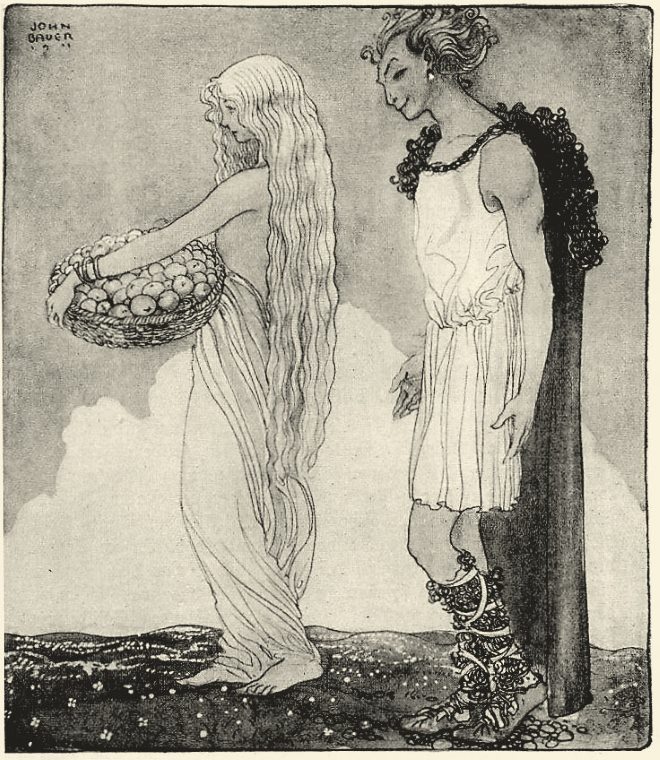
Baltic & Slavic Paganism
Additional forms of Paganism from other regions of Europe, such as the Baltic and Slavic regions, have their own ties with trees. These ties are hugely similar to the aforementioned forms of European Paganism, and particularly with regards to the World Tree and also respective thunder gods being linked with oak trees. For example, Perkūnas and Perun, from the Baltic and Slavic regions respectively, are associated with the oak, and thus sacred groves dedicated to them would certainly have contained oak trees (Chadwick, 1900). Such groves, at least for the Slavs, would have been ‘managed’ by a great hierarchy of priests (Altman, 2000).
For the Slavic people, the oak may also sometimes have featured within shrines to the god Radegast, or have been used for religious activities as the religion dwindled following the Christianisation of Europe (Thompson, 1916). These oaks (and those beyond), and additionally mature beech trees (Fagus sylvatica), were also understood to have been imbued with souls in Slavic cultures, whilst for the Baltic Pagans the ash (Fraxinus excelsior), lime (Tilia cordata) and oak (Quercus robur) were considered particularly sacred, by virtue of their large mature size (Altman, 2000) – the lime was generally revered by the females so that the tree could bring fertility and good fortune to their homes, whilst the oak was a masculine tree worshipped by the men (de Cleene & Lejeune, 1999). Furthermore, the island of Rügen, which to the indigenous Slavs was sacred to their god Rugevit, also contained his sacred rowan trees (Sorbus aucuparia), which graced the island is seeming abundance (Jones & Pennick, 1995). Furthermore, and unsurprisingly, much like other areas of Pagan Europe during the Christianisation period, sacred groves of the Slavs were destroyed. One example of such desecration was when bishop Wigbert of Merseberg cut down a sacred grove during the first few years of the 11th century (Zaroff, 2001). In recent times, the emergence of Neo-Paganism has actually led to some groves within Slavic countries regaining their once central position within the Slavic culture (Shnirelman, 2002).
Ancient Greek religion
The religion of Ancient Greece, albeit geographically and temporally disjointed and spanning over perhaps many millennia and peoples, is a further form of polytheism that has some very interesting links with the arboreal world – both physically and symbolically. Many centuries prior to the more well-known period of Ancient Greece that graced the world with philosophers such as Plato and Aristotle, there did exist two Greek civilisations that thrived (up until 1,100 B.C.): the Minoan (3500 B.C. – 1450 B.C.) and Mycenaean (1600 B.C. – 1100 B.C.) civilisations (Cusack, 2011). The latter, in particular, is considered to have influenced the more contemporary religion in Ancient Greece, and there does exist a small wealth of information – courtesy largely of the work of Evans (1901) – relating to trees within the religion of the Mycenae. There do, nonetheless, also exist sources that detail – albeit to a lesser degree – how trees featured within the earlier religion of the Minoans (Cusack, 2011; Goodison, 2009).
With regards to trees in the Mycenaean civilisation, Evans (1901) notes that there was in fact a dualism of the sacred tree and the sacred pillar, from which the latter could be made from the former; even after the death of the original sacred tree. Such sacred trees may have been represented in the form of a variety of different tree species including: cypress (Cupressus sp.), fig (Ficus carica)., palm (Phoenix theophrasti), pine (Pinus sp.), and plane (Platanus orientalis). The latter, in particular, was considered to have been linked with Zeus (‘The God of the Double Axe‘), as in the plane did he form union with the goddess Europa. The fig, on the other hand, was considered a gift from the goddess of agriculture known as Demeter (Evans, 1901; Hageneder, 2005).
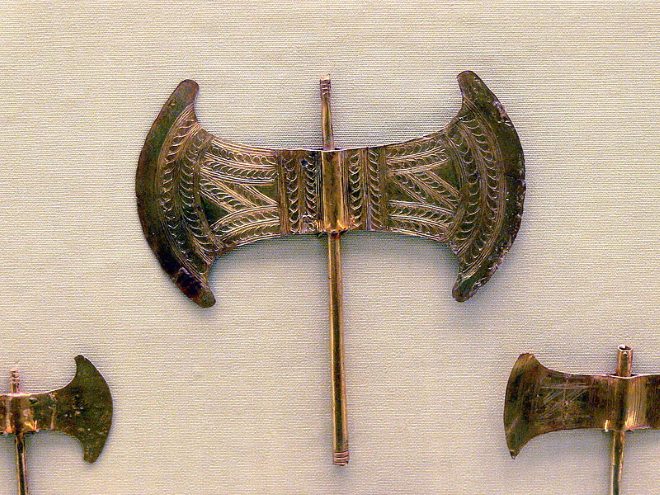
Such trees, because of their sanctity, would have been present within and around shrines to various gods and (principally) goddesses within the civilisation’s geographical area (notably rural locations), in the form of individual specimens or groves. Where single trees occupied a sacred site, it is very likely – if not a certainty – that the tree was the physical representation of the deity being revered, and therefore the imago mundi (Evans, 1901). Thus, it is not surprising that there did exist groves of plane trees in which Zeus could be worshipped, as were there olive groves where Demeter could be worshipped (such as at Eleusis). In fact, the fig has associations with many Mycenaean deities beyond Demeter, including Dionysus, who is worshipped in the form of a fig tree (Hageneder, 2005; James, 1966), and also Gaia, where a fig tree did immediately grow after she protected her son from the thunderbolts of Zeus. The second symbolic reference to the fig may have arisen because of the fig tree’s warding of lightning (Evans, 1901).
For the earlier Minoan civilisation, as detailed, there is also a small (but growing) degree of evidence available for understanding how their religion was associated with trees. A principal reason for the current lack of understanding is because their means of transcribing information, known as Linear A and Linear B, are still largely untranslated – notably with regards to Linear A (Farrar, 2016). However, it can be confidently asserted that there was, at the least, a sacred tree that was associated with an unnamed goddess considered to be (one of, or an early amalgamation of all) Athene, Artemis, Eileithyia, or Hera (Cusack, 2011; Farrar, 2016) – this sacred tree would have been enclosed, as a sacred site (potentially a grove), within a walled or otherwise demarcated area, and would likely have been an olive (Olea europaea), fig (Ficus carica), or palm (Phoenix theophrasti) (Cusack, 2011; Farrar, 2016); though perhaps also an oak (Quercus sp.) (Castleden, 1990) or terebinth (Pistacia terebinthus) (Farrar, 2016).
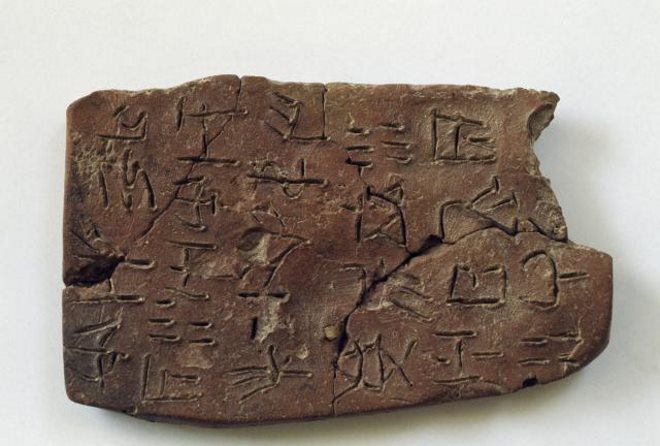
Within this sacred site, ceremonies would have been held and tree worship would undoubtedly have occurred, and the ceremonies would have consisted of activities including dances, the shaking of trees, sacrifice, and lamentation and mourning (de Cleene & Lejeune, 1999; Marinatos, 2010; Nilsson, 1950). Touching specifically upon the concept of tree shaking, it is considered to have been a manner in which the tree shaker (understood to always have been a male) could enable those within the sacred site to connect with the goddess (through vision and summoning her presence), and sometimes in a state of somewhat orgiastic “religious frenzy” (Galanakis, 2005; Marinatos, 2004). Because the central sacred tree of the site would also – as Cusack (2011) and Meagher (1995) remark – have represented the goddess and thus would have been directly revered, the Minoans considered the tree an imago mundi. It is unclear whether the central tree was the one that would be shaken by the male worshippers. Evidence also exists of trees within these sacred sites being protected by constructed guards, in a fashion very much akin to modern day tree protection systems (Farrar, 2016).
Following the collapse of the Mycenaean and Minoan civilisations, there was a period that spanned across many centuries, akin to the slightly more contemporary Dark Ages of Europe. At the uprising of a more advanced Greek (Hellenic) civilisation once again however (from the 8th century B.C.), one can observe how these older Mycenaean and Minoan traditions had persisted (Farrar, 2016). Granted, the more ‘rustic’ and minimalist sacred spaces of the older civilisations were sometimes replaced with far more lavish and anthropocentric shrines and temples, complete with gardens, dedicated to their specific gods and goddesses (Farrar, 2016).
For the sake of intrigue, in cases where temples were erected, the timber of tree species including cedar (Cedrus libani), cypress (Cupressus sp.), elm (Ulmus sp.), hackberry (Celtis australis), oak (Quercus sp.), olive (Olea europaea), and pine (Pinus sp.) were used (Rackham, 2001). However, the core tenets of worship remained similar, therefore meaning the worship of deities such as Zeus persisted, and took place amongst groves of oak, such as at Dodona (Altman, 2000; Evans, 1901; Hooke, 2012). In this location, it was said that a particularly sacred oak – amongst a larger forest of sacred oak – spoke directly from Zeus (through the rustling of its leaves, and from the running spring waters emanating from around the roots – this stream was the source of Divine Life, of which the oak is a repository of the divine water), and a bronze statue did exist within, adorned with a crown of oak leaves and acorns, of Zeus (Altman, 2000; Cook, 1903). Twin pillars in the heart of the oak woods that dressed Mount Lykaion were also a site of worship to Zeus (Evans, 1901), and there were undoubtedly many other additional locations for these sacred oak groves (Rackham, 2001). The beech (Fagus sylvatica) was also linked with Zeus (Altman, 2000).
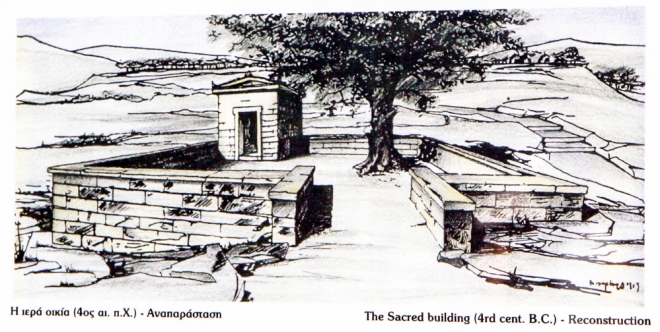
As was the case in the more historic Mycenaean era, the plane also retained its associations with Zeus, and particularly upon the island of Crete (Evans, 1901). Upon this island, a sacred cave sanctuary of Zeus on Mount Ida was also graced with a grove at its entrance, and in this instance the grove comprised of black poplar (Populus nigra). These black poplar not only represented the “chthonic transition” between the mortal realm and that of the gods, but were also home to the mother goddess and her followers (Bonnechere, 2007; Evans, 1901).
There were, of course, deities other than Zeus worshipped within groves consisting of various tree species, including Apollo, Artemis, Athene, Persephone, Poseidon, and Trophonios, and the groves were typically, if not exclusively, publicly-accessible (Altman, 2000; Bonnechere, 2007; de Cleene & Lejeune, 1999; Thommen, 2015). Such public accessibility eventually led to these sacred groves also becoming places of learning and athletics (including gymnasiums) – these practices were often overseen by the elite (Thommen, 2015). In some instances, these sacred groves would also have been artificially planted. For example, as noted by Rackham (2015), the grove of cypresses at Nemea was not a natural grove. However, sacred groves would have sometimes been far more secluded, in order to create the necessary conditions for religious awe and reverence (Wright, 1921).

With regards to the tree species associated with Greek deities and religious figures beyond Zeus, the list is certainly not small. For example, Aphrodite’s sacred trees were the apple (Malus sp.), myrtle (Myrtus communis), and tamarisk (Tamarix sp.), whilst Athene was associated with the olive, having brought the olive (Olea europaea) up from the earth following Poseidon’s flooding of the Acropolis, and – as detailed in Homer’s Odyssey as the earliest sacred grove referenced in Greek literature – the poplar (Populus sp.). Daphne, who was not a goddess but a nymph, in order to evade Apollo, morphed into a laurel tree (Laurus nobilis) – the laurel was also attributed to Apollo, because of his love for the tree, in response to Daphne transforming into the laurel. The cypress (Cupressus sempervirens) is also a genus with links to Apollo, for Apollo turned the young Kyparissos into a cypress tree after he begged to be able to mourn the loss of his pet stag (that Kyparissos had inadvertently killed) for eternity.
Furthermore, the box (Buxus sempervirens), as a symbol of immortality and mourning, was tied to the god of the underworld known as Hades, as was the plane (Platanus orientalis) also used to mark where Hades entered the underworld. Hecate’s sacred tree was the yew (Taxus baccata) as a result of the yew also symbolising death and immortality, much like the box. Additionally, Persephone had ties with the pomegranate (Punica granatum), white poplar (Populus alba) and oriental plane (Platanus orientalis), and Poseidon was linked with the pine (Pinus maritima and Pinus pinea), because of the genus’ timber being used for boats and rafts. Priapus, the misshapen child (an over-sized phallus) of Aphrodite and Dionysus, whilst not necessarily associated with a specific tree, was considered the guardian of orchards, thereby connecting him to fruit trees of the genera Malus and Pyrus, and the European olive (Olea europaea), fig (Ficus carica), and pomegranate (Punica granatum) (Altman, 2000; Cusack, 2011; de Cleene & Lejeune, 1999; Farrar, 2016; Hageneder, 2005). Of course, this list is not extensive, and only delicately excavates the surface with regards to how different tree species had various religious associations.
At the revival of the Greek civilisation, one can also observe how the sacred tree as the imago mundi had persisted. In the cosmogeny produced by Pherecydes of Syros during the sixth century B.C., which detailed his outlook on how the cosmos came into existence, it can be seen how the tree as the imago mundi is the culmination of the creation story. In the account of creation, Pherecydes of Syros writes that Zas (a craftsman deity, who later became Zeus) married Chthonie (a goddess represented by a winged oak tree), and crafted her a robe as a gift. When Chthonie donned the robe, which upon it was a detailed image of earthly features, she was transformed into the earth and became known as the goddess Ge (Gaia). This transformation of the female winged oak into the earth, it is suggested, signifies how this particular oak (and more generally the tree) became the imago mundi, through the creation of the world by Zas (Cusack, 2011; James, 1966).
Interestingly, this birth of the world from a feminine identity differs from the Indo-European masculine origins of the earth (James, 1966). However, this creation myth did not gain any notable amount of traction within Greek culture following its writing – perhaps, in part, because it lacked prior reference points within the Greek world view (West, 2007) – and instead the Greeks transitioned towards a general deification of nature through Gaia. For instance, woodlands were seen as being home to an abundance of wood nymphs (dryads; or hamadryads) and satyrs, and sacred sites would usually be located within the natural landscape (Cusack, 2011). Of course, such sites would still likely have contained sacred trees that were representative of the world (as a microcosm), and therefore could still be classed as the imago mundi. Conversely, such as with the shrine to Zeus at Dodona, there is scope to suggest the shrine serves as the axis mundi (Cusack, 2011).
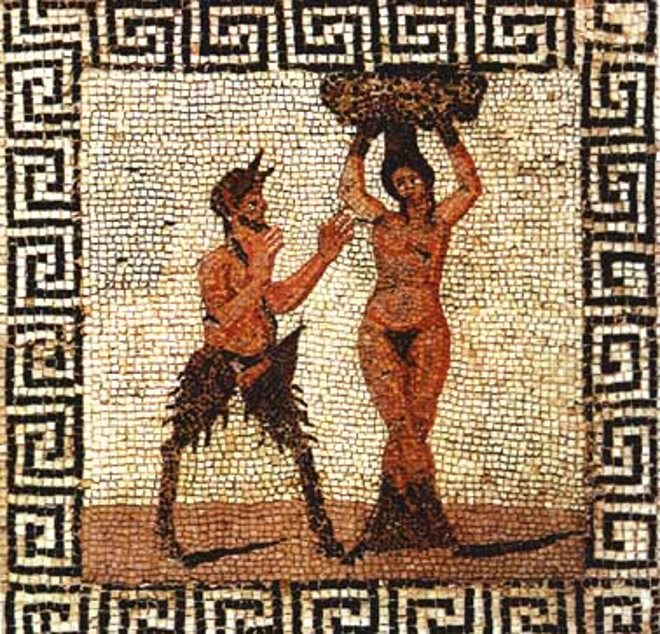
Whilst on the topic of Ancient Greece, it is also necessary to turn attention towards the Classical Greek (fifth and fourth century B.C.) and Hellenistic Greek (fourth century to first century B.C.) periods that arose at the advent of what is now considered Western philosophy (Farrar, 2016). These periods are important because they were – at least in part – responsible for the shaping of some of the later monotheistic religions, and have certainly had a lasting effect on the Western man’s understanding of the position that plants occupy on the moral and sentient continuum.
Operating chronologically, and using Hall (2011) for exclusive reference (unless otherwise detailed), the earlier Archaic period that pre-dated the Classical era, which saw the rise of philosophers such as Anaximenes, Empedocles, Thales, and Xenophanes, had led to the establishment (through the incorporation of existing religious doctrine) of all beings coming from God. This meant that, on the rawest of levels, man and plants (including trees) shared a divine origin, though this origin did see man and animal take benefit from the plant life through the consumption of plants. However, it was important that the origin of all life was recognised as being from the divine, and therefore it was not considered justifiable to be excessively violent towards plants – non-violence was encouraged, with only the necessary amount of suffering being inflicted to plant life. Granted, for Xenophanes, who lived during the later period of the Archaic era, this kinship was questioned, and from this point onwards an ever-more dualistic approach to man and plant philosophy manifested.
Subsequently, at the emergence of Plato in the Classical period, and notably after his writings in the publication entitled Timaeus, this dualism became markedly distinct. Plato distinguished between ‘higher’ and ‘lower’ forms of being, with the ‘lower’ lacking intelligence and rationality. In this ‘lower’ ranking were plants, whilst the essence of ‘higher’ beings (humans and animals) were eternal and unchanging. Therefore, plants existed, whether overtly stated or not, to serve humans and animals, and their positioning on the hierarchy being lower enabled them to become subjects of unrestrained violence. Hall (2011) alleges that such a positioning by Plato of plants was to rationalise why not all beings are deserving of equal respect – a rationalisation that would have numerous desirable political impacts, such as with the treatment of slaves and the use (without moral dilemmas) of plant materials for humans. Aristotle, a student of Plato, continued this line of thought, and in his work on souls determined that plants possessed the lowest form of soil: the nutritive soul. This meant that, like Plato had taught, plants lacked awareness and mentality.
Following on from Aristotle came Theophrastus. Having originally learned from Plato before his death, Theophrastus then was taken under the wing of Aristotle. Unlike his predecessors however, Theophrastus divorced himself from the zoocentric approach to studying plant life, and his works on botanical matters led him to become known as the ‘father of botany’. In his research, which was far more empirical than Aristotle’s, Theophrastus identified that plants live for themselves and not for humans (see Historia Plantarum), therefore removing them from the lowly position they previously occupied. His work also enabled him to recognise that plants were able to perceive and sense, and these traits made them sensory beings. It was even remarked that trees had preferences and sought enjoyment, by selectively choosing environments that they would grow most optimally in. This ability for trees (and plants, more broadly) to sense and enjoy also meant, according to Theophrastus, that they could suffer, and subsequently they would fall into the realm of moral consideration with regards to their use by humans. Granted, he did suggest that the cultivation of trees and other crops is not necessarily a bad thing, as whilst the plants are removed from their natural environment, they are provided with water and nutrients aplenty, which they would otherwise have to aggressively compete for. Unfortunately, this Theophrastan view of the plant world was not adopted by the mainstream, and thus the zoocentric Aristotelean view became pervasive.
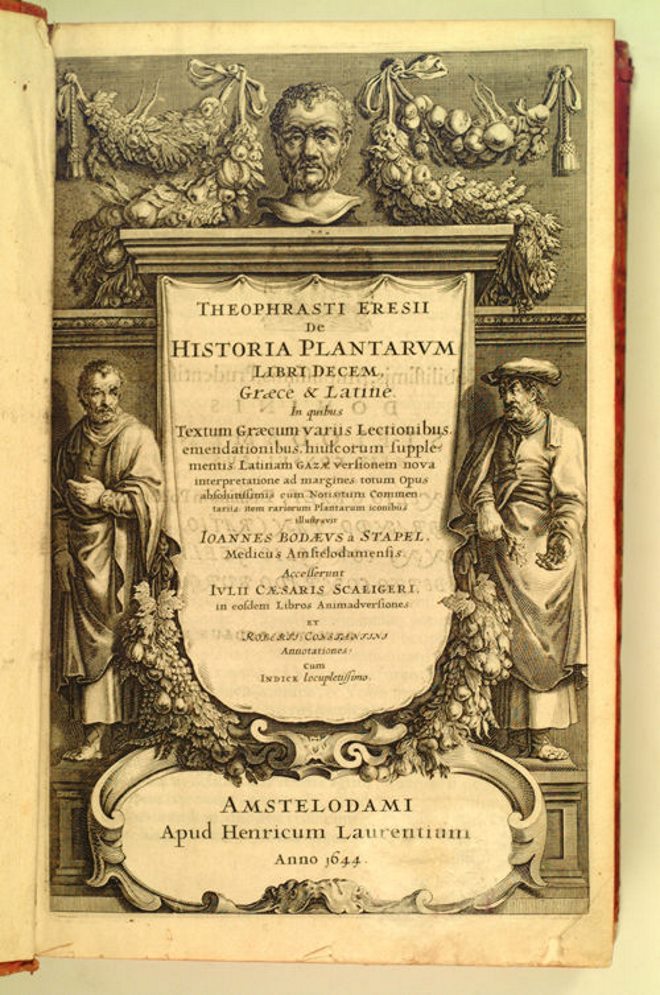
Ancient Roman religion
At around the same time that the Archaic Greek period began, Italy saw the emergence of a new civilisation: Rome. Widely renowned for their eventual domination of much of Europe, and the subsequent Christianisation of their lands, the initial polytheistic religion (that took influence from many neighbouring religions, and particularly that of the Greeks), unsurprisingly and in much the same way to the religion of Ancient Greece, had an array of associations with trees (Cusack, 2011).
However, in spite of this deliberate emulation of the Ancient Greeks’ religion, the religion of Ancient Rome lacked any extensive depth, and therefore did not possess the mythological context that supported the intricacies of the influencing Ancient Greek religion with regards to trees. As a consequence, there is little to no evidence of the tree being the imago mundi, and only a limited amount of evidence for the tree as the axis mundi. The latter largely comes in the form of pillars (adorned with carvings of oak leaves), found mostly in the Rhineland and eastern Gaul, used to worship Jupiter (the Roman equivalent of Zeus) and to commemorate the death of Romulus (Cusack, 2011). Temples of Jupiter may also have been built on sites where sacred oak did reside, and where groves did exist they were sacred to Diana (Dowden, 2000).
Because of how the religion of Ancient Rome developed, it is not at all surprising that the associations Roman deities had with trees generally mirrored the associations from the religion of Ancient Greece. As ascertained above, the oak was tied with Jupiter, who was the Roman equivalent of the Greek deity Zeus. Beyond this however, one can observe how the consort of Jupiter, a female deity known as Juno, also had links with the oak, by wearing a crown made from its leaves (Cusack, 2011). Her equivalent in Ancient Greece, known as Hera, was also considered (in some sources) to be linked with the oak, as outlined by Castleden (1990). The goddess Minerva, synonymous with Athene of the Ancient Greeks, was therefore unsurprisingly connected to the olive (Olea europaea), as was Venus (synonymous with Aphrodite) linked with the myrtle (Myrtus communis) (Altman, 2000; Hall, 2011). Pomona, the goddess of fruit and who is considered to be similar to the Greek goddess Demeter, is also intertwined with trees, by sheer virtue of her role within the Roman pantheon (de Cleene & Lejeune, 1999).
Beyond the similarity between Greek and Roman Pagan deities, the Roman branch of Paganism offers further evidence of its use of trees in the symbolic sense. One pertinent example of the symbolic value of trees is how the fig (Ficus sp.) at Palatine Hill was associated with the milk goddess Rumina (ficus Ruminalis), because of the fig’s sap being markedly similar to breast milk. Under this tree did the twins Romulus and Remus, who were born from the god Mars and abandoned by their mother (only to then be saved through a series of events), suckle from a she-wolf. Some years later, Romulus went on to found the city of Rome, and thus the beginning of the Roman Empire was at his hands, and the fig on Palatine Hill became known as the ficus Romularis. At his death this hill became his burial place, and thus the fig – now acting as a sacred tree pillar (influenced by the Ancient Greek pillar cult of Mycenae) – became an axis mundi (Cusack, 2011).
References
Altman, N. (2000) Sacred Trees: Spirituality, Wisdom & Well-Being. USA: Sterling Publishing.
Andrén, A. (2014) Tracing Old Norse Cosmology: The World Tree, Middle Earth, and the Sun in archaeological perspectives. Sweden: Nordic Academic Press.
Bachrach, B. (2013) Charlemagne’s Early Campaigns (768-777): A Diplomatic and Military Analysis. The Netherlands: BRILL.
Bonnechere, P. (2007) The Place of the Sacred Grove (Alsos) in the Mantic Rituals of Greece: The Example of the Alsos of Trophonios at Lebadeia (Boeotia). In Conan, M. (ed.) Sacred Gardens and Landscapes: Ritual and Agency. China: Dumbarton Oaks Research Library and Collection.
Butt, J. (2002) Daily Life in the Age of Charlemagne. USA: The Greenwood Press.
Cambria, E. (2015) The Esoteric Codex: Anglo-Saxon Paganism. USA: Lulu.com.
Castleden, R. (1990) Minoans: Life in Bronze Age Crete. UK: Routledge.
Cerveny, R. (1994) Power of Ancient cultures were grounded. Weatherwise. 47 (2). p20-23.
Chadwick, H. (1900) The oak and the thunder-god. Journal of the Anthropological Institute of Great Britain and Ireland. 30 (1). p22-44.
Cook, A. (1903) Zeus, Jupiter and the oak. The Classical Review. 17 (3). p174-186.
Cusack, C. (2011) The Sacred Tree: Ancient and Medieval Manifestations. UK: Cambridge Scholars Publishing.
Daniels, C. & Stevans, C. (2003) Encyclopedia of Superstitions, Folklore, and the Occult Sciences of the World: Volume II. USA: University Press of the Pacific.
Davidson, H. (1988) Myths and Symbols in Pagan Europe: Early Scandinavian and Celtic Religions. USA: Syracuse University Press.
de Cleene, M. & Lejeune, M. (1999) Compendium of Symbolic and Ritual Plants in Europe – Volume I: Trees & Shrubs. Belgium: Mens & Cultuur.
Dowden, K. (2000) European Paganism: The Realities of Cult from Antiquity to the Middle Ages. UK: Routledge.
Dunn, M. (2013) Belief and Religion in Barbarian Europe c. 350-700. UK: Bloomsbury.
Evans, A. (1901) The Mycenaean Tree and Pillar Cult and its Mediterranean Relations. USA: Macmillan and Co.
Farrar, L. (2016) Gardens and Gardeners of the Ancient World: History, myth & archaeology. UK: Windgather Press.
Forest, D. (2014) Celtic Tree Magic: Ogham Lore and Druid Mysteries. USA: Llewellyn.
Francis, M. (2014) Local Worship, Global Church: Popular Religion and the Liturgy. USA: Liturgical Press.
Galanakis, K. (2005) Minoan Glyptic: Typology, Deposits and Iconography – From the Early Minoan Period to the Late Minoan IB Destruction in Crete. UK: British Archaeological Reports.
Gardiner, P. (2007) Gateways to the Otherworld: The Secrets Beyond the Final Journey, from the Egyptian Underworld to the Gates in the Sky. USA: The Career Press.
Goodison, L. (2009) “Why All This about Oak or Stone?”: Trees and Boulders in Minoan Religion. Hesperia Supplements. 42 (1). p51-57.
Gummere, F. (1892) Germanic Origins: A study in primitive culture. USA: Charles Scribner’s Sons.
Haberman, D. (2013) People Trees: Worship of Trees in Northern India. USA: Oxford University Press.
Hageneder, F. (2000) The Spirit of Trees: Science, Symbiosis, and Inspiration. Poland: Floris Books.
Hageneder, F. (2005) The Meaning of Trees: Botany – History – Healing – Lore. USA: Chronicle Books.
Hall, M. (2011) Plants as Persons: A Philosophical Botany. USA: Suny Press.
Hayman, R. (2003) Trees: Woodlands and Western Civilization. UK: Hambledon and London.
Hooke, D. (2010) Trees in Anglo-Saxon England: Literature, Lore and Landscape. UK: The Boydell Press.
Hooke, D. (2012) Tree Symbolism throughout History. In Rotherham, I., Handley, C., Agnoletti, M., & Samojlik, T. (eds.) Trees Beyond the Wood: an exploration of concepts of woods, forests and trees. UK: Wildtrack Publishing.
Jagendorf, M. (1962) Apples in life and lore. New York Folklore. 18 (4). p273-283.
James, E. (1966) The Tree of Life: An Archaeological Study. The Netherlands: BRILL.
Jones, P. & Pennick, N. (1995) A History of Pagan Europe. UK: Routledge.
Layser, E. (2000) From pagans to presidents. The World & I. 15 (12). p168-173.
Lechler, G. (1937) The tree of life in Indo-European and Islamic cultures. Ars Islamica. 4 (1). p369-419.
Mac Cana, P. (2011) The Cult of the Sacred Centre: Essays on Celtic Ideology. Ireland: Dublin Institute for Advanced Studies.
Macculloch, J. (1911) The Religion of the Ancient Celts. UK: Morrison & Gibb Limited.
MacNeill, J. (1908) Notes on the distribution, history, grammar, and import of the Irish ogham inscriptions. Proceedings of the Royal Irish Academy Section C: Archaeology, Celtic Studies, History, Linguistics, Literature. 27 (1). p329-370.
Marinatos, N. (2004) The Character of Minoan Epiphanies. Illinois Classical Studies. 29 (1). p25-42.
Marinatos, N. (2010) Minoan Kingship and the Solar Goddess: A Near Eastern Koine. USA: University of Illinois Press.
Meagher, R. (1995) The Meaning of Helen: In Search of an Ancient Icon. USA: Bolchazy-Carducci Publishers, Inc.
Murphy, G. (2013) Tree of Salvation: Yggdrasil and the Cross in the North. USA: Oxford University Press.
Nilsson, M. (1950) The Minoan-Mycenaean Religion and Its Survival in Greek Religion. 2nd ed. USA: Biblo and Tannen.
Orton, P. (2005) Pagan Myth and Religion. In McTurk, R. (ed.) A Companion to Old Norse-Icelandic Literature and Culture. UK: Blackwell Publishing.
Rackham, O. (2001) Trees, Wood, and Timber in Greek History. UK: Leopard’s Head Press.
Rackham, O. (2015) Greek Landscapes: Profane and Sacred. In Kappel, L. & Pothou, V. (eds.) Human Development in Sacred Landscapes: Between Ritual Tradition, Creativity and Emotionality. Germany: V&R Unipress.
Rhody, N. (2012) The Heliand: The Warrior’s Strength and the Transcendence of Faith. Journal of Undergraduate Research at Minnesota State University, Mankato. 12 (9). p1-38.
Schrader, R. (1983) Sacred Groves, Marvellous Waters, and Grendel’s Abode. Florilegium. 5 (1). p76-84.
Shnirelman, V. (2002) “Christians! Go home”: A Revival of Neo-Paganism between the Baltic Sea and Transcaucasia (an overview). Journal of Contemporary Religion. 17 (2). p197-211.
Simek, R. (2014) Continental Germanic religion. In Christensen, L., Hammer, O., & Warburton, D. (eds.) The Handbook of Religions in Ancient Europe. UK: Routledge.
Skoglund, P. (2012) The Significance of Trees: An archaeological perspective. UK: BAR Publishing.
Tauring, K. (2007) The Runes: A Human Journey. USA: Lulu.com.
Thommen, L. (2015) Sacred Groves: Nature between Religion, Philosophy and Politics. In Käppel, L. & Pothou, V. (eds.) Human Development in Sacred Landscapes: Between Ritual Tradition, Creativity and Emotionality. Germany: V&R Unipress.
Thompson, J. (1916) The German Church and the Conversion of the Baltic Slavs: Concluded. The American Journal of Theology. 20 (3). p372-389.
Tolley, C. (2013) What is a ‘World Tree’, and Should We Expect to Find One Growing in Anglo-Saxon England?. In Bintley, M. & Shapland, M. (eds.) Trees and Timber in the Anglo-Saxon World. USA: Oxford University Press.
Viladesau, R. (2006) The Beauty of the Cross: The Passion of Christ in Theology and the Arts from the Catacombs to the Eve of the Renaissance. USA: Oxford University Press.
West, M. (2007) Indo-European Poetry and Myth. UK: Oxford University Press.
Wilson, D. (2005) Charlemagne: The Great Adventure. UK: Hutchinson.
Wright, D. (1921) The Affinity of Druidism with Other Religions. The Open Court. 35 (3). p129-140.
Zaroff, R. (2001) Perception of Christianity by the Pagan Polabian Slavs. Studia Mythologica Slavica. 4 (1). p81-96.

[…] European Paganism (which was covered recently here), there exist, as detailed by Hall (2011), many other indigenous animistic religions that share […]
LikeLike
[…] “Anglian myth of the sacrificial king known as Ingui, who married, in spring, a woman who was the manifestation of the goddess of the land, and was killed the following spring by another man and hung upon a tree, is a further reference to trees within Anglo-Saxon Paganism – in particular, the cosmic tree (Cusack, 2011). With regards to the worship of gods and goddesses within sacred groves by the Anglo-Saxons, it is understood that a grove would be a sacred site of solely one deity” https://arboriculture.wordpress.com/2016/10/16/trees-and-religion-paganism/ […]
LikeLike
Reblogged this on Die Goldene Landschaft.
LikeLike
[…] https://arboriculture.wordpress.com/2016/10/16/trees-and-religion-paganism/ […]
LikeLike
[…] https://arboriculture.wordpress.com/2016/10/16/trees-and-religion-paganism/ […]
LikeLike
[…] Blog, Trees and Religion – Paganism, 16 October […]
LikeLike
[…] Pagan tree worship is a practice that is mentioned in the Bible. In the Book of Leviticus, God tells Moses that the people of Israel are not to engage in this practice. However, it is clear that pagans continued to worship trees after the Israelites left Egypt. In the Book of Isaiah, the prophet condemns the practice of pagan tree worship and says that those who engage in it will be destroyed. […]
LikeLike